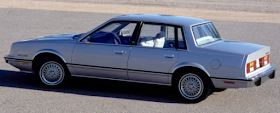The Tempo and Topaz sold well at first, despite their styling that seemed odd to some. The 1970s were a time when styling fashion called for light, crispy boxy designs with large window areas and thin roofs. The new Ford products were more rounded, of course, and had other features giving them a too-soft appearance. That was my reaction at the time. It still is, though to a lesser extent, as I'll discuss in the comments below.
First, a few strong examples of the boxy fashion common before wind tunnel tested aerodynamic styling emerged. This is a 1982 Chevrolet Celebrity. Its windshield is at a strong angle and the hood curves down towards the front, but the rest of the car is angular with a vertical feeling imposed by the central and aft roof pillars, the upright backlight and squared-off rear end. Note the thin roof and sharp angles of the window profiles -- these strongly contrast the equivalent Tempo and Topaz details.
1981 Dodge Reliant, an early Chrysler Corporation K car. Again, angular with a thin roof.
A 1981 Ford Fairmont, the sort of Ford marketed before aerodynamics kicked in. Again, we need to contrast the passenger compartment greenhouse with that of the new models.
Here is a 1984 Ford Tempo four-door sedan. Like the Celebrity and Fairmont shown above, it is a six-window style. The roof is slightly more rounded. The window framing is also more rounded -- not much, but enough to be noticed.
Near side-view of a 1985 Tempo four-door. Its sides are slightly pushed out compared to the Fairmont and Reliant, and its fender transitions to the hood and trunk are more highly radiused than on the Celebrity and Reliant. These differences are not large in themselves, but in combination with the window framing they give the design a soft appearance. At the time I thought that more angles were needed to make the car less flabby seeming. I still think so, and would concentrate on the window framing. Since the mid-1980s stylists have leaned to add such contrasts to aerodynamically shaped bodies.
1985 two-door Tempo. Its fewer window pillars help lighten its design.
Now for the Mercury Topaz. This low-quality image of a 1984 four-door sedan reveals that such sedans had four windows, not six. The result is a cleaner, less-fussy design.
A for-sale 1984 Topaz showing its grille.
And an image of a beat-up, for-sale '84 Topaz included because it shows the rear styling that is more angular than that of the Tempo.
Finally, a sporty two-door Topaz from 1987.










The Ford, more than the Mercury, has very strong visual links to the British Ford Sierra between the A and C pillar. I'm assuming this was a much larger car than the Sierra, so it's probably just a case of "family" styling.
ReplyDelete@ Unknown; Same size as the Sierra, roughly speaking, with a slightly lower market positioning.
ReplyDeleteThe one thing I'd have done differently is black out the heavy chrome window surrounds as was done on the Sport GL models (like the two-door '85). This would've visually lightened and thinnned the pillars, especially on light-colored cars. It also (speaking as a former owner) would've eliminated considerable glare from the horizontal surfaces of them in the driver's eyes, an annoyance at best and a real safety hazard at worst.
No, the Tempo was a bit smaller than the Sierra. Two inches more wheelbase and length, about the same width. A two door version of the Sierra was sold in the US as a Mercury Merkur. The successors to the Tempo/Topaz was the Contour/Mystique, sold in the UK as a Montego, so not just looking similar but basically the same. Maybe this batch will be covered here - interesting relation between US/UK styling and face lifts.
ReplyDeleteAaargh, no edit function. The "two inches more" in the second sentence refers to the Sierra, to fix any confusion.
ReplyDelete